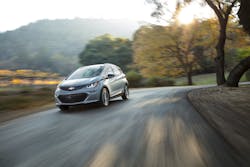For fleets looking to reduce their carbon footprint, diversify their vehicles and save money, electric vehicles (EVs) can be a viable alternative to conventionally fueled vehicles.
“Electric drive vehicles provide documented benefits in emissions reduction and performance,” says Genevieve Cullen, president, Electric Drive Transportation Association (EDTA). The EDTA (www.electricdrive.org) is the cross-industry trade association which promotes the advancement of electric drive technology and electrified transportation.
“Because the technology allows for flexibility in how electric drive solutions can be applied across different vehicle platforms, manufacturers are able to meet the increasingly diverse operational demands of consumers and businesses,” she adds, “These solutions have been applied in light duty cars and trucks, buses, utility vehicles, medium and heavy duty transportation and mobile equipment, just to name a few electric drive vehicle options, and these are available at a variety of price points.”
EVs start to look good when you look at emissions, says Alexander Barton, director of accreditation development, National Association of Fleet Administrators (NAFA) Fleet Management Association (www.nafa.org), a not-for-profit association for professionals who manage fleets. “EVs have zero emissions from the tailpipe and use an electric grid as a power source that is readily available. Sometimes that power source is clean, whether that is produced by solar or wind (power). Sometimes it is produced by coal power plants, so you’d have offsets there.”
He says that in terms of fleets, efficiency and time and monetary savings, EVs are a “nice way to go” if the vehicles stay close to their domicile and don’t go any further than 40 miles. Drivers would be able to go about their daily jobs and charge the EVs overnight. Or, if the has a quick charge station, vehicles can be charged for an hour or two over a lunch period.
TYPES OF EVS
There are currently a few different types of EVs available on the market. These include:
- Standard electric vehicles (EVs), powered only by one or more electric motors. These receive electricity by plugging into the grid and storing energy in batteries. They consume no petroleum-based fuel while driving and produce no tailpipe emissions.
- Hybrid electric vehicles (HEVs) combine an internal combustion engine (ICE) or other propulsion source with batteries, regenerative braking and an electric motor to provide high fuel economy. They rely on a petroleum-based or alternative fuel for power and are not plugged in to charge. HEV batteries are charged by the ICE or other propulsion source and during regenerative braking.
- Plug-in electric vehicles (PEVs) derive all or part of their power from electricity supplied by the electric grid. They include EVs and PHEVs (plug-in hybrid electric vehicles). PHEVs, which use batteries to power an electric motor, plug into the grid to charge and use a petroleum-based or alternative fuel to power an ICE or other propulsion source.
MARKET AVAILABILITY
Almost every major vehicle manufacturer has at least one plug-in vehicle in the market now, or one in the works, and more are on the way, says EDTA’s Cullen. “By the end of 2016, approximately 40 plug-in electric drive vehicles will be on the market.”
NAFA’s Barton notes that EV makes and models are increasing in the market and fleets are starting to pay more attention to this type of vehicle. “Everyone knows about Tesla,” he says, because the company has gained a lot of excitement because of the way its vehicles look and perform.
Because the same lithium-ion battery technology that Tesla uses is now open sourced, other OEs, such as GM and Nissan, are breaking into this technology to considerably extend the range of EVs. For instance, he says the “Chevy Bolt is a pure EV model with 200-mile range.”
BARRIERS AGAINST EVs
Lack of awareness of the variety and benefits of electric drive options is a market challenge that the EDTA and its members, among others, are working together to address, says group’s Cullen.
NAFA’s Barton says range anxiety plays a large part for fleets that are worried about EV adoption. He describes range anxiety thusly: When a driver is in the vehicle, they’re always watching the power gauge and wondering where they can get the vehicle charged up and not be stranded somewhere, unable to work.
He adds that just as with any other new vehicle, there is a learning curve. Once the drivers get into the vehicles and drive them, they will get used to trusting the EV range.
Mark Goody, manager, electric vehicle programs for FleetCarma (www.fleetcarma.com) – a connected car platform that helps organizations effectively deploy, utilize, monitor and smart-charge electric vehicles – , says there are three key barriers to EV adoption:
- Lack of public and workplace charging infrastructure. “This results in the phenomenon of range anxiety, in which consumers fear running out of range, and thus look electric vehicles as a risk.”
- Availability of different EV models. “While OEMs have recently made a huge push towards growing the number of electric vehicles available to the market, there are very few electric SUVs or trucks, which would be very appealing to different fleet needs or applications.
- Uncertainty. “When considering the purchase of an electric vehicle, I believe most people raise too many questions or concerns that they are not able to satisfy, leaving them skeptical and unsure of how the technology would work for them.”
Goody adds that additional concerns can include:
- What will my electricity costs be?
- What is my operating cost per mile?
- How long will I need to charge for?
- Will I need an EV or a PHEV?
- What is my payback using my criteria?
By answering these questions before considering an EV, the fleet will have more confidence in the capabilities of an EV and be more likely to invest, as they will know how it will perform, rather than hoping for the best, he says.
IDENTIFY YOUR NEEDS
To determine whether or not an EV makes sense for your fleet, you have to look at application, says NAFA’s Barton, and know what job are you trying to do with it and what is this vehicle is going to be used for? It is helpful to find a partner – such as a fleet management company or someone with knowledge with EVs – to help with the decision. If EVs are a fit, they “can’t be beat in terms of the emissions and GHG reduction and petroleum consumption reduction that they offer.”
To determine if an EV makes sense, fleets must do their homework, adds FleetCarma’s Goody. “This includes understanding how many miles will be driven each and every day, as this will help determine if an EV or PHEV is more suitable. Look up the different models on the internet to evaluate which particular models are best suited for your particular needs.
“It is also important to understand how much charging your vehicle will need, if you will be able to charge at work and what your electricity costs will be. In a fleet application, the answer to this question is more complex. There are more vehicles to consider and bigger spending budgets, which mean a lot more risk to the bottom line.”
FleetCarma offers an EV suitability assessment technology to automate fleet total cost of ownership calculations custom to each of the fleet's duty cycles, and uses this data to model and simulate the suitability of different plug-in vehicles in each of those duty cycles. This allows the fleet manager to evaluate EV risk and reward, identifying areas for EV adoption and total cost of ownership savings, says Goody.
The EDTA offers a similar guide (http://goelectricdrive.org/home/plug-in-roadmap). The group’s Cullen says: “As with any other vehicle purchase, consumers need to identify their driving needs (use, size, cost) and match the options to their needs.”
TAX BREAKS AND ADDITIONAL INCENTIVES
There is a federal tax credit currently available for the purchase of plug-in electric drive vehicles, up to $7,500, as well as an incentive for installing charging infrastructure – a credit scheduled to expire at the end of 2016, says the EDTA’s Cullen. She says there are also numerous state incentives, which can be found on the EDTA’s website: http://goelectricdrive.org/select-country/united-states
These rebates make it very attractive to offset that initial cost of EVs, says NAFA’s Barton. Although, he adds that the cost of EVs is dropping, in general.
Another incentive to purchasing an EV is that, compared to conventionally fueled vehicles, gas prices are constantly fluctuating, but electricity will always be cheaper than gas, says NAFA’s Barton. “Particularly if you are generating the electricity yourself. If you’re a fleet manager and have your own infrastructure developed – say you have a solar canopy and you’re able to charge off that canopy, that’s your own power and you can often enough sell that back to the grid.”
Although everyone agrees that most rebates will come from the government, vehicle manufacturers and dealers may also offer limited-time incentives. Check automaker websites and local dealers to check availability, says Cullen.
EVs can be a great opportunity for fleets to reduce emissions and cost on fuel. The initial cost of the EVs may seem higher than conventionally fueled vehicles, but with federal tax incentives, the lower cost of electricity when compared to gas and the lighter impact of electricity on carbon emissions than petroleum, EVs are a viable option for many fleets.

